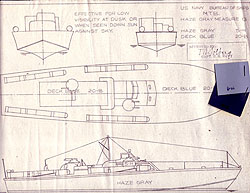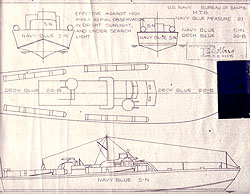|
We have all seen PT boat models painted in camouflage schemes such as Measure 31/5P, the Adaptor Scheme, Measure 31/20L and variations of them. What I am going to present here are different Camouflage Measures that were either applied to boats in service or are 'experimental' schemes that never saw application. These drawings were supplied to me by my honored colleague Tracy White of www.researcher@large.com. However, bear in mind that the bottoms of the PT boats were painted in an anti-fouling paint called Copperoyd no matter what scheme the boat(s) wore. It was reddish in color, but more like a muddied rust hue of red.
One thing that I have found out recently that I don't think that a lot of people know and I think that some experts will debate; is that the rudders of PT boats were left in their 'natural metal' state and were not painted.
The first scheme we see is called MTB Haze Gray Measure 13. This scheme consisted of Haze Gray, 5-H and Deck Blue, 20-B. The scheme was effective for low visibility at dusk or when seen down sun against the sky. All horizontal surfaces were painted in Haze Gray, 5-H and all vertical surfaces and decks were painted Deck Blue, 20-B.

click thumbnail for larger view
Another scheme was MTB Navy Blue Measure 21. The scheme consisted of Navy Blue, 5-N and Deck Blue, 20-B. This scheme was effective against angle aerial observation in bright sunlight and under search light.

click thumbnail for larger view
Here are some photos of a PT Squadron 4 (the Training Squadron from the PT Training Center in Melville, Rhode Island) apparently wearing Measure 21.
click thumbnails for larger view
These photos were also supplied to me by Mr. Tracy White of www.researcher@large.com.
MTB Measure 32, Camouflage Design 7-P is an interesting looking scheme. This scheme consisted of Light Gray, 5-L, MTB Green (made by mixing one gallon Navy Green, 5-NG), Ocean Gray, 5-O, Deck Green, 20-G. This scheme was described as a compromise low visibility scheme which was particularly effective at dawn and at sunset.
click thumbnail for larger view
One scheme that I don't think was used operationally was MTB Measure 32, Camouflage Design 8-P. This scheme consisted of Deck Blue, 20-B, Pale Gray, 5-P, Ocean Gray, 5-O, Navy Blue, 5-N. This scheme was effective for course deception. It could be applied with sharp or soft edge application.
click thumbnail for larger view
MTB Measure 33, Camouflage Design 7-P consisted of Pale Green, 5-PG, Ocean Green, 5-OG, and Deck Green, 20-G. It was effective for having low visibility in overcast conditions, pre-dawn and twilight conditions and at night. It could be applied with either soft-edged or splotched application.
click thumbnail for larger view
The MTB Green Measure consisted of MTB Green and Deck Green, 20-G. This scheme was generally effective under the same conditions as Measure 31, Design 7-P, but Measure 31 breaks up the lines of the boat against shore background due to its pattern.
I hope these drawings and this data helps modelers and history buffs alike.
|